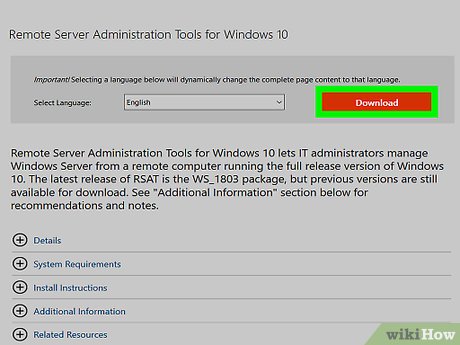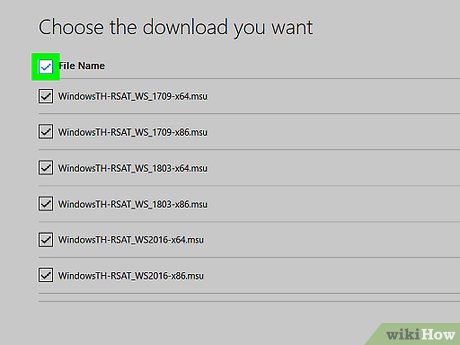How to Enable Active Directory in Windows 10
Install Remote Server Administration Tools

Go to https://www.microsoft.com/en-us/download/details.aspx?id=45520 in a web browser. If left by default, Active Directory does not come with Windows 10, so you will have to download it from Microsoft.
If you are not using Windows 10 Professional or Enterprise, you will not be able to install.

Click Download . This button is red. You may have to scroll down a bit to find this button.

Check the box next to 'File Name'. This is the step to select all files in the list.

Click Next .

Download all 4 files to your computer. Because there are many files you need to download, click Save for all (download multiple files) if asked.

Open the Downloads folder. You will find this folder in This PC or on the desktop.

Install all 4 files. Double-click the first file, then follow the on-screen instructions to complete the installation. Do the same with the other files you just downloaded.
Enable Active Directory

Open Control Panel. To do this, type control panelin the search bar, then click Control Panel in the results that appear.

Click Programs .

Click Turn Windows features on or off . A dialog box will be displayed.

Scroll down and click the + sign next to 'Remote Server Administration Tools'. A list of tools will open.

Click the + sign next to 'Role Administration Tools'.

Check the box next to 'AD DS Tools'. Windows will install some files and ask you to restart your computer.

Click Restart now . The computer will be turned off and turned back on. When the computer is turned back on, you can use Active Directory tools through Windows Administrative Tools in the Start menu.
You should read it
- How to Enable Active Directory in Windows 10
- How to install Active Directory on Windows Server 2019
- Prepare Active Directory for Exchange 2007 (P.4)
- Network basics: Part 9 - Information about Active Directory
- Top 10 security settings after installing Active Directory
- Restore deleted components in Active Directory
- Instructions for installing Active Directory on Windows Server 2008
- Prevent deleting data in Windows Server 2003 Active Directory
May be interested
- Network basics: Part 9 - Information about Active Directory
 in the last part of this article series, i have talked about active directory and how it works with network domain controllers. in this section, we will continue to introduce it to you
in the last part of this article series, i have talked about active directory and how it works with network domain controllers. in this section, we will continue to introduce it to you - Top 10 security settings after installing Active Directory
 installing active directory is not too difficult, but once you have installed it, there is quite a bit of work to do. the first thing in active directory configuration is its security settings. there are many areas you need to consider and many settings need to be changed in preparation for protecting actions in the starboard
installing active directory is not too difficult, but once you have installed it, there is quite a bit of work to do. the first thing in active directory configuration is its security settings. there are many areas you need to consider and many settings need to be changed in preparation for protecting actions in the starboard - Fix Windows error that cannot connect to domain
 after your computer has been logged in as a member of the active directory domain for a while or when domain members use virtual software, you will encounter some errors.
after your computer has been logged in as a member of the active directory domain for a while or when domain members use virtual software, you will encounter some errors. - Prepare Active Directory for Exchange 2007 (Part 3)
 in the previous two sections, we took the first necessary action when preparing active directory to receive exchange 2007, which is the process of preparing the legacy exchange permission.
in the previous two sections, we took the first necessary action when preparing active directory to receive exchange 2007, which is the process of preparing the legacy exchange permission. - Change the 'life cycle' of tombstone objects in Active Directory
 in the previous article, i showed you how to recover deleted components in active directory, which are related to the lifecycle properties of tombstone objects. technically this lifetime must be set longer than the fixed latency between domain controllers. period of cycles between x & a times
in the previous article, i showed you how to recover deleted components in active directory, which are related to the lifecycle properties of tombstone objects. technically this lifetime must be set longer than the fixed latency between domain controllers. period of cycles between x & a times - How to Back Up Active Directory in Windows
 active directory is a network structure that stores domain and network information about all computers and devices as well as user and device software settings. it resides on each domain controller in an organization and replicates itself...
active directory is a network structure that stores domain and network information about all computers and devices as well as user and device software settings. it resides on each domain controller in an organization and replicates itself... - Prepare Active Directory for Exchange 2007 (Part 1)
 before installing exchange 2007 you need to learn some steps to take to prepare an active directory environment to receive exchange 2007.
before installing exchange 2007 you need to learn some steps to take to prepare an active directory environment to receive exchange 2007. - How to check which Domain Controller holds the FSMO role in Active Directory
 this tutorial illustrates how to test the fsmo role in server 2016. the 5 fsmo roles in active directory include: rid master, pdc emulator master, infrastructure master, domain naming master, schema master.
this tutorial illustrates how to test the fsmo role in server 2016. the 5 fsmo roles in active directory include: rid master, pdc emulator master, infrastructure master, domain naming master, schema master. - Prepare Active Directory for Exchange 2007 (Part 2)
 in part one, we went over the first four steps to take to prepare the active directory schema to receive exchange 2007.
in part one, we went over the first four steps to take to prepare the active directory schema to receive exchange 2007. - Extend the Active Directory schema capabilities in Exchange Server 2007
 in this article, i will show you how to extend exchange server 2007's microsoft active directory schema and why active directory schema extensions are necessary.
in this article, i will show you how to extend exchange server 2007's microsoft active directory schema and why active directory schema extensions are necessary.










 How to Change Desktop Wallpaper on Windows
How to Change Desktop Wallpaper on Windows How to Use the Net Send command
How to Use the Net Send command How to Activate Windows XP without a genuine product key
How to Activate Windows XP without a genuine product key How to Install Windows Vista Operating System
How to Install Windows Vista Operating System How to Create and Delete Files or Folders from Windows Command Prompt
How to Create and Delete Files or Folders from Windows Command Prompt How to Change Language in Windows 7
How to Change Language in Windows 7